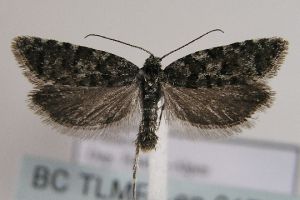2. Diagnose
2.1. Falter
3. Biologie
3.1. Nahrung der Raupe
Noch unbekannt! Whitebread (2006: 193) versuchte aber, eine Klärung herbeizuführen, was zu vielen offenen Fragen führte: "The larva of this species has not been found, but the adult has often been seen around Silene acaulis and this is probably a foodplant of the species. A female was taken 23rd July 1984 at Schwarzsee, below the Matterhorn, Zermatt, Switzerland (Fig. 1C). It used its proboscis to take in water provided on cotton wool. About 30 eggs were laid over the following six days, when the female died. They were laid under a rock, under leaves of Saxifraga oppositifolia and on the lid of the plastic container. They were initially yellow and some were loosely covered by particles of sand and anal hairs of the female. They turned reddish after about 2 days and darkened after 7 days. After 11 days, some eggs were opened and fully developed larvae were released. The remaining eggs hatched naturally one week later. The neonate larvae were reddish with a black head and plate. They did not feed on the provided Saxifraga. It is possible that this is not their natural foodplant, or the provided conditions were simply not conducive to feeding. Alternatively, perhaps the young larva hibernates without feeding, or that in the wild, the larvae overwinter fully developed in the egg."
4. Weitere Informationen
4.1. Faunistik
Nach Whitebread (2006) kommt die Art in der Schweiz (Wallis), in Frankreich (Pyrenäen) und in Italien (Alpen im Nordwesten des Landes) vor. Die Art fand noch keinen Eingang in die [Fauna Europaea, last update 23 July 2012, version 2.5].
(Autor: Erwin Rennwald)
4.2. Literatur
- Erstbeschreibung: Whitebread, S. (2006): Sphaleroptera alpicolana (Frölich 1830) (Lepidoptera: Tortricidae, Cnephasiini): a species complex. — Veröffentlichungen des Tiroler Landesmuseums Ferdinandeum 86: 177-204. [PDF auf zobodat.at]




![Vorkommen in Frankreich (europäisches Territorium ohne Korsika) [Vandromme et al. (2020): Liste systématique et taxinomique des Lépidoptères de France]](/res/img/flag/fr.gif)
![Vorkommen in Spanien (Festland) [Vives Moreno A. (2014)]](/res/img/flag/es.gif)



